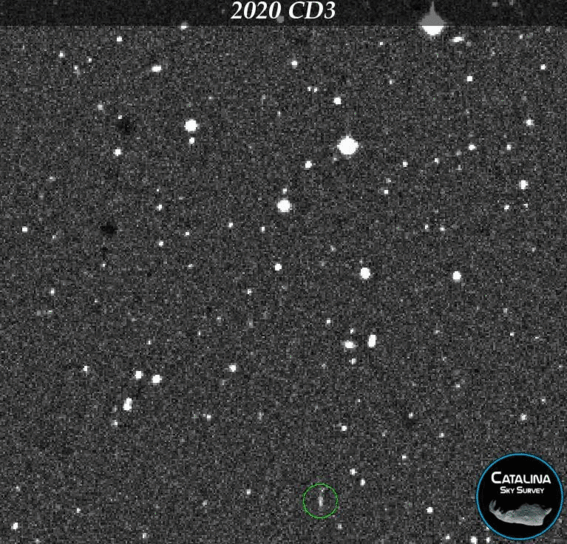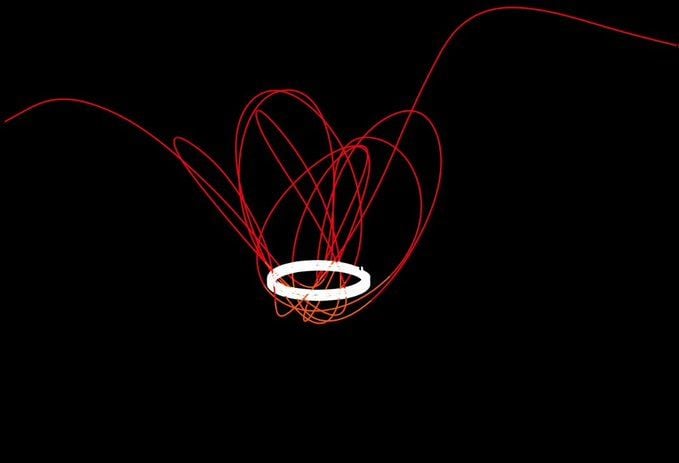Earth’s New Mini-Moon Is Leaving Soon
Our planet is just one stop along the car-sized asteroid’s solar system odyssey
/https://tf-cmsv2-smithsonianmag-media.s3.amazonaws.com/filer/c8/a9/c8a9933b-0a23-421b-9443-5810a9c2f310/2020_march4_minimoon.jpg)
Not only does Earth have a second, miniature moon, it may have been there for at least a year and nobody noticed, the Catalina Sky Survey announced late last month.
The mini-moon was first spotted on February 15th when two astronomers at the Catalina Sky Survey in Arizona watched a white blur shoot across a backdrop of motionless stars. It was an unexpected find: no known asteroid or space junk was registered on its orbit. The Arizona astronomers Teddy Pruyne and Kacper Wierzchos registered the object, named 2020 CD3, in an online database run by the Harvard-Smithsonian Center for Astrophysics.
Then, astronomers around the world moved quickly to confirm it. For now, the small space rock is tracing a complex path around Earth. But experts say it could break away as soon as next week or as late as April.
“Unfortunately, we are catching this one on its way back out,” Bill Gray, whose software helped astronomers pinpoint the mini-moon’s location, tells the Atlantic’s Marina Koren. “It’s getting fainter. Already, it’s faint enough that if the Catalina Sky Survey looked at it now, it wouldn’t see it.”

By February 25, the international Gemini Observatory captured a photo of the visiting asteroid. The 26-foot telescope followed 2020 CD3 as it sailed past, making the stars behind it look like streaks of color and the tiny moon look like a white spot in the center of the frame.
This is the second time that an unexpected asteroid has been spotted circling Earth. The first mini-moon was registered in 2006 and departed by 2007. Earth gains mini-moons when asteroids orbiting the sun try to skate by Earth, and the planet’s gravity pulls them off track just enough that they stick around, instead of just slightly bending their path or taking a nose-dive toward Earth’s surface.
It’s a delicate balance, but University of Canterbury astronomer Michele Bannister tells Rebecca Boyle at the New York Times that mini-moons may actually be very common.
“They are orbiting roughly the same space that we are, and some will get into the right spot where it can nudge into a ballet with us. And then it’s like any dance: you do a couple spins together, and go your separate ways,” she tells the Times. “There’s something beautifully transient about it.”
By another estimate, Earth probably has at least one two-foot-wide mini-moon at any given time, and one the size of 2020 CD3 about once every decade, per the Times.

Wierzchos described the mini-moon’s orbit as “chaotic,” per Space’s Elizabeth Howell. The mini-moon is being tugged not only by Earth’s gravity, but also by our long-term moon, so 2020-CD3 has been as close as one-fifth the average distance between Earth and the moon, and as far as four and a half times the same measurement. Based on the software that models the mini-moon’s orbit, it probably joined Earth in about 2017, and will only stick around for a few more weeks.
In the statement by Catalina Sky Survey, the astronomers explained that it’s probably not the leftovers from an abandoned spacecraft because it doesn’t seem to be pushed around by solar radiation pressure—the force exerted by light pushing on an object. An empty spacecraft is easy to push around, compared to a dense piece of rock.
But, Wierzchos adds to Space, "The possibility it is artificial still exists, so I am trying to be cautious with every statement. I'd hate it to be artificial after [everyone is] making a fuss [about the discovery]."
Because not many observatories have gotten a clear look at the mini-moon, astronomers haven’t had a chance to take measurements that would reveal what it’s made of. If it’s the most common type of asteroid, then it’s probably smaller than a compact car. At this point, only the largest professional telescopes can see it now.
It seems like we only just met 2020 CD3, and when it leaves, it probably won’t be goodbye forever. The 2006 mini-moon is due to return around August 2028, and our newest visitor is likely to return someday as well. NASA’s Jet Propulsion Laboratory estimates about a three percent chance that it will collide with Earth in the next 100 years. If that happens, it will mostly burn up in the atmosphere without causing any damage on the ground. But it’s more likely that the asteroid will just fly by or take another do-si-do around Earth.
For now, it’s on its way out—so consider waving goodbye next time you look up at the night sky.